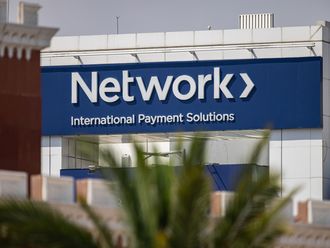NEW YORK: The leading US investment banks — Goldman Sachs and Morgan Stanley — each reported third quarter profits that beat analysts’ expectations on Tuesday, helped by strong performance in their trading operations and better-than-expected revenue from stock underwriting.
Goldman Sachs, the larger of the two banks, reported a profit of $2.52 billion (Dh9.25 billion) in the quarter, or $6.28 per share. That’s up from $2.13 billion, or $5.02 per share, in the same period a year earlier. The result topped the estimate of $5.38 per share from Wall Street analysts, according to FactSet.
Meanwhile, Morgan Stanley earned a profit of $2.11 billion, or $1.17 per share, which is up 19 per cent from a year ago, when the bank earned $1.78 billion, or 93 cents per share. The results beat analysts’ estimates of $1.01 per share, according to FactSet.
Goldman shares rose 1.4 per cent to $218.15 in premarket trading, while Morgan shares gained 2.7 per cent to $44.65.
Both banks make most of their money from advising wealthy clients and corporations on deals, as well as substantial trading operations. While both banks trade stocks, bonds, commodities and currencies, Morgan is known more for its stock trading operations while Goldman leans more into bonds, commodities and currencies.
Stock underwriting revenues were unexpectedly healthy at both banks, helped by more companies going public. Morgan had equity underwriting revenues of $441 million from $273 million a year ago, and Goldman reported underwriting revenues of $1.06 billion, up 20 per cent from 2017.
Morgan’s revenue from stock sales and trading — a core business for the bank — was $2.0 billion in the quarter, up from $1.9 billion in the same period a year earlier. In comparison, Goldman had net revenues in stock trading of $1.79 billion, up 8 per cent from a year earlier, despite what Goldman described as “lower client activity” in the quarter.
During the third quarter, both banks saw little change in their individual advisory businesses. The third quarter is typically the quietest for both banks, with summer putting many dealmakers on vacation and August being a particularly slow month for US businesses. Morgan reported $510 million in advisory revenues in the quarter, down from $555 million in the same period a year earlier. Goldman’s advisory revenues were $916 million, essentially flat compared to a year ago.
Goldman’s return on equity, which measures an investment bank’s profitability by how well it performs with the assets it holds, was 13.1 per cent in the quarter. Morgan Stanley’s return on equity was 11.5 per cent. Both banks aim to have their return on equity ratios above 10 per cent.
Morgan Stanley’s wealth management arm also had a solid quarter, reporting a pre-tax profit of $1.2 billion. The wealth management business has been a focus for Morgan’s top management for some time, as the bank has looked to diversify its businesses after the financial crisis. Morgan saw clients bring more assets under management during the quarter, and the bank grew interest income, helped by a recent push by Morgan Stanley to do lending to asset management clients using their wealth as collateral.
Firm wide, Goldman Sachs reported revenues of $8.65 billion and Morgan had net revenues of $9.87 billion.










